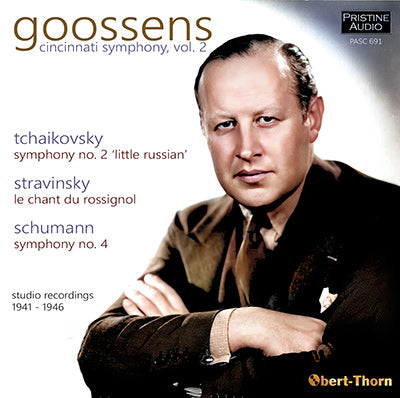
- Producer's Note
- Full Track Listing
- Cover Art
This volume is the second of three in a series which will present the complete recordings of Eugene Goossens and the Cincinnati Symphony Orchestra. Goossens was particularly known for his championing of contemporary music and for his interpretations of Russian works; and in the present program, we feature one that satisfies the second criterion (Tchaikovsky) and another which checks both boxes (Stravinsky), along with a classic of German Romanticism (Schumann).
Goossens was born into a musical family in London in 1893. His Belgian grandfather had been a conductor; his father, a violinist; his mother, an opera singer; and his siblings all noted instrumentalists (oboist Léon, harpists Sidonie and Marie and hornist Adolphe). After studying violin and playing in various London orchestras and chamber ensembles, Goossens became an assistant to Beecham in 1916. By 1921, he had taken up conducting full-time, forming his own orchestra, and making a particular specialty of new music. In the same year, he gave the British concert première of Stravinsky’s The Rite of Spring.
At the invitation of George Eastman, Goossens served as music director of the Rochester Philharmonic and taught at the Eastman School of Music from 1923 to 1931, splitting his time between the USA and Britain, where he continued to conduct in the concert hall and at Covent Garden. He led the Hollywood Bowl Orchestra frequently during his years in America, and made recordings there in 1928. From 1931 through 1946, he headed the Cincinnati Symphony before moving to Australia to conduct the Sydney Symphony (1947-56) and lead the New South Wales State Conservatorium of Music, where among his students were Joan Sutherland and Richard Bonynge. He was knighted in 1955; but his career suffered from a scandal the following year which caused his return to the UK. He died in 1962.
The Cincinnati Symphony had already enjoyed an illustrious history before Goossens’ arrival. Its previous music directors had included Leopold Stokowski (1909-12), violinist-turned-conductor Eugene Ysaÿe (1918-22) and Fritz Reiner (1922-31). Although the ensemble had recorded acoustically under Ernst Kunwald and Ysaÿe in 1917-19, they had not made any discs in over two decades until the February, 1941 sessions that produced, among other items, the Tchaikovsky symphony presented here.
Goossens’ Schumann discography is small; besides the symphony included here, he recorded only Glazunov’s orchestration of Carnaval and the Piano Concerto, the latter in three versions with three different pianists (Bela Siki, Peter Katin and Benno Moiseiwitsch) for three labels (Pye, Everest and HMV) over three consecutive years (1958-60). His reading of the Fourth Symphony emphasizes flowing lyricism over the more aggressive forward propulsion heard in other versions.
The recording of Le Chant du rossignol heard here was the first complete version to be made. Goossens’ long association with Stravinsky’s works (he recorded a complete Petrushka as early as 1923-24, reissued on
Goossens’ Tchaikovsky discography is more substantial, including from the 78 rpm era two versions of the Nutcracker Suite (acoustic and electric), the 1812 Overture and excerpts from Sleeping Beauty; and from the LP era the Manfred Symphony, the Violin Concerto with Ida Haendel and a movement from the First Piano Concerto with Moiseiwitsch. His only version of the “Little Russian” Symphony, made at the end of his first group of sessions in Cincinnati, has been characterized by critic Robert Matthew-Walker as “possibly Goossens’s greatest recording and a reading which has not been equalled on disc.” In the final movement, the ensemble plays like men possessed, with an astonishing rhythmic drive.
GOOSSENS Cincinnati Symphony, Vol. 2
SCHUMANN Symphony No. 4 in D minor, Op. 120
- 1. 1st Mvt. – Ziemlich langsam - Lebhaft (8:30)
- 2. 2nd Mvt. – Romanze: Ziemlich langsam (3:42)
- 3. 3rd Mvt. – Scherzo: Lebhaft (4:52)
- 4. 4th Mvt. – Langsam - Lebhaft (7:32)
Recorded 14 February 1946 ∙ Matrices: D6-RC-5133/8 ∙ First issued on RCA Victor 11-9593/5 in album M-1124
STRAVINSKY Le Chant du rossignol (Poème symphonique)
- 5. Introduction - La fête au palais de l'empereur de Chine (The Feast at the Emperor's palace) (2:26)
- 6. Marche chinoise (Chinese March)(3:12)
- 7. Chant du rossignol (Song of the Nightingale)(3:08)
- 8. Jeu du rossignol mécanique (The Mechanical Nightingale)(10:26)
Recorded 25 January 1945 ∙ Matrices: D5-RC-669/73 ∙ First issued on RCA Victor 11-9094/6 in album M-1041
TCHAIKOVSKY Symphony No. 2 in C minor, Op. 17, “Little Russian”
- 9. 1st Mvt. – Andante sostenuto - Allegro vivo (9:26)
- 10. 2nd Mvt. – Andantino marziale, quasi moderato (7:08)
- 11. 3rd Mvt. – Scherzo. Allegro molto vivace (4:21)
- 12. 4th Mvt. – Finale. Moderato assai - Allegro vivo (9:22)
Recorded 20 February 1941 ∙ Matrices: CS 062515/22∙ First issued on Victor 18035/8 in album M-790
Eugene Goossens ∙ Cincinnati Symphony Orchestra
Producer and Audio Restoration Engineer:
Special thanks to Nathan Brown and Charles Niss for providing source material
All recordings made in the Cincinnati Music Hall, Cincinnati, Ohio
Total timing: 74:10

